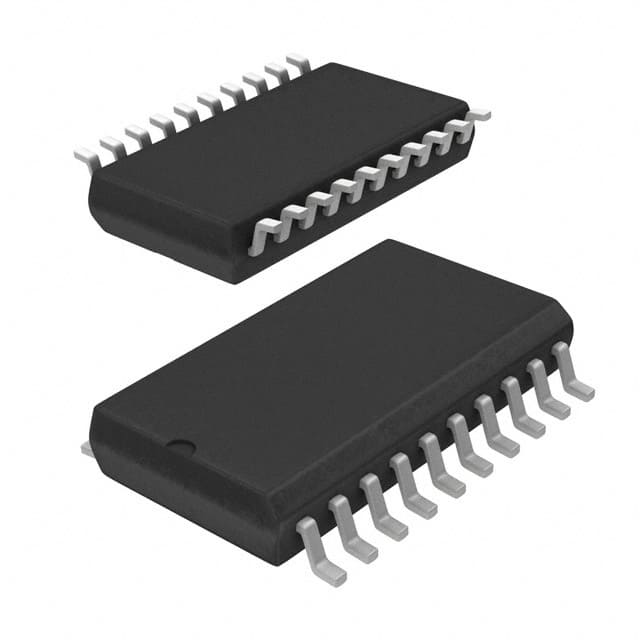Lihat spesifikasi untuk detail produk.

Encyclopedia Entry: 74ACTQ573SJ
Product Overview
Category
The 74ACTQ573SJ belongs to the category of integrated circuits (ICs).
Use
This IC is commonly used in digital electronic systems for data storage and transfer purposes.
Characteristics
- The 74ACTQ573SJ is a latch with transparent D-type inputs and outputs.
- It operates on a wide voltage range, typically between 2V and 6V.
- This IC has a high-speed operation, making it suitable for applications requiring quick data transfer.
- It offers low power consumption, making it energy-efficient.
Package
The 74ACTQ573SJ is available in a small outline integrated circuit (SOIC) package.
Essence
The essence of this IC lies in its ability to store and transfer digital data efficiently within electronic systems.
Packaging/Quantity
Typically, the 74ACTQ573SJ is sold in reels containing multiple units. The exact quantity may vary depending on the supplier.
Specifications
- Supply Voltage Range: 2V to 6V
- Input Voltage Range: 0V to VCC
- Output Voltage Range: 0V to VCC
- Operating Temperature Range: -40°C to +85°C
- Maximum Clock Frequency: 200 MHz
- Number of Inputs: 8
- Number of Outputs: 8
Detailed Pin Configuration
The 74ACTQ573SJ has a total of 20 pins. Here is the detailed pin configuration:
- GND (Ground)
- D0 (Data Input 0)
- D1 (Data Input 1)
- D2 (Data Input 2)
- D3 (Data Input 3)
- D4 (Data Input 4)
- D5 (Data Input 5)
- D6 (Data Input 6)
- D7 (Data Input 7)
- OE (Output Enable)
- LE (Latch Enable)
- Q0 (Output 0)
- Q1 (Output 1)
- Q2 (Output 2)
- Q3 (Output 3)
- Q4 (Output 4)
- Q5 (Output 5)
- Q6 (Output 6)
- Q7 (Output 7)
- VCC (Supply Voltage)
Functional Features
The key functional features of the 74ACTQ573SJ include:
- Transparent latch operation: The IC allows data to pass through when the latch enable (LE) input is high.
- Output enable control: The output enable (OE) input can be used to disable the outputs, preventing any changes in stored data.
- High-speed operation: The IC operates at a maximum clock frequency of 200 MHz, enabling rapid data transfer.
- Data storage: The IC can store digital data on its eight D-type inputs and retain it until a new value is latched.
Advantages and Disadvantages
Advantages
- Wide voltage range allows compatibility with various electronic systems.
- High-speed operation facilitates quick data transfer.
- Low power consumption makes it energy-efficient.
- Transparent latch operation enables real-time data processing.
Disadvantages
- Limited number of inputs and outputs may restrict its use in complex systems.
- Requires external components for proper functioning.
Working Principles
The 74ACTQ573SJ operates based on the principles of digital logic circuits. When the latch enable (LE) input is high, the IC allows data from the D-type inputs to pass through to the outputs. The output enable (OE) input controls whether the outputs are enabled or disabled. The IC stores the data on its inputs until a new value is latched.
Detailed Application Field Plans
The 74ACTQ573SJ finds applications in various digital electronic systems, including:
- Microcontrollers: Used for data storage and transfer between the microcontroller and other peripherals.
- Communication Systems: Facilitates data transmission and reception in communication devices.
- Memory Modules: Enables efficient data storage and retrieval in memory modules.
- Industrial Automation: Used in control systems for storing and transferring digital signals.
- Automotive Electronics: Utilized in automotive control units for data processing and storage.
Detailed and Complete Alternative Models
Some alternative models that serve similar functions to the 74ACTQ573SJ include:
- 74HC573: A latch with similar characteristics but operates at a lower voltage range.
- 74LS573: A latch with comparable features but operates at a slower speed.
- CD74ACT573: Another latch IC with similar specifications and functionality.
These alternative models can be considered based on specific requirements and system compatibility.
In conclusion, the 74ACTQ573SJ is an integrated circuit commonly used for data storage and transfer in digital electronic systems. Its high
Sebutkan 10 pertanyaan dan jawaban umum terkait penerapan 74ACTQ573SJ dalam solusi teknis
Sure! Here are 10 common questions and answers related to the application of 74ACTQ573SJ in technical solutions:
1. What is the 74ACTQ573SJ? - The 74ACTQ573SJ is a octal transparent latch with 3-state outputs, commonly used in digital circuits.
2. What is the purpose of the 74ACTQ573SJ? - The purpose of this IC is to store and hold data temporarily, allowing for synchronized data transfer between different parts of a digital system.
3. What is the maximum operating voltage for the 74ACTQ573SJ? - The maximum operating voltage for this IC is typically 5.5 volts.
4. How many latch inputs does the 74ACTQ573SJ have? - The 74ACTQ573SJ has eight latch inputs, labeled from D0 to D7.
5. Can the 74ACTQ573SJ be used as a bidirectional buffer? - No, the 74ACTQ573SJ is not designed to function as a bidirectional buffer. It only supports unidirectional data transfer.
6. What is the output current capability of the 74ACTQ573SJ? - The output current capability of this IC is typically around 24 mA.
7. Does the 74ACTQ573SJ have any built-in protection features? - Yes, it has built-in diode clamps on all inputs to protect against electrostatic discharge (ESD) events.
8. Can the 74ACTQ573SJ operate at high speeds? - Yes, the 74ACTQ573SJ is designed for high-speed operation and can handle frequencies up to several hundred megahertz.
9. Is the 74ACTQ573SJ compatible with other logic families? - Yes, the 74ACTQ573SJ is compatible with a wide range of logic families, including TTL, CMOS, and LVTTL.
10. What are some typical applications for the 74ACTQ573SJ? - Some typical applications include data storage in microprocessors, address latching in memory systems, and general-purpose digital signal buffering.
Please note that the answers provided here are general and may vary depending on specific datasheet specifications and application requirements.

